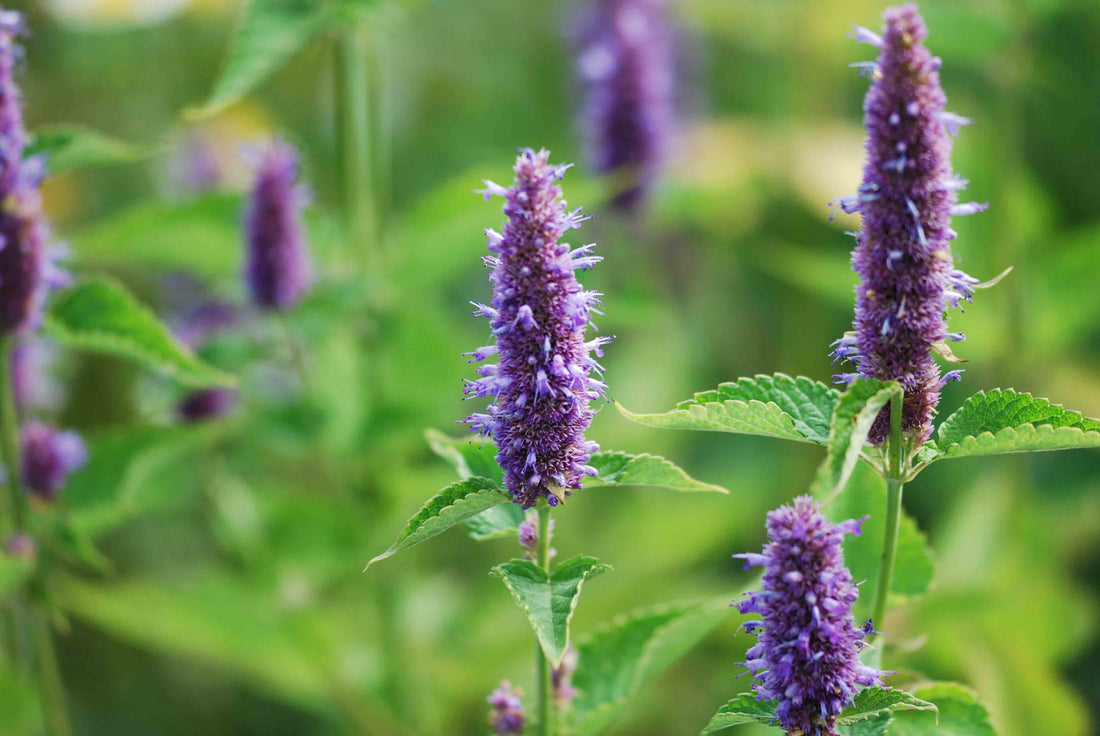
Successful cultivation of agastache
Native to North America, agastache is a beautiful, ornamental, and honey-producing herb that is very hardy* and undemanding. Its bright blue flowers exude a powerful aniseed scent. Used as an aromatic and condiment in North American and Asian cuisines, the flowers decorate dishes, and the leaves are used in infusions or in cooking as anise substitutes, to flavor raw vegetables, salads, fish, drinks, or cakes.
Article Summary
A little history about agastache
Latin name : Agastache foeniculum
Order : Lamiales
Family : Lamiaceae
Genre : Agastache
Species : Agastache

The history of agastache
The various species of agastache (such as aniseed agastache or rugosa agastache) are native to China, Japan, and North America. There, they were often used primarily as ornamental plants, before being later combined with aromatic plants.
Etymology
The word "agastache" comes from the Greek aga, meaning abundance, and stachys, meaning ear. Foeniculum is the Latin name for fennel.
Taste
Agastache has a strong aniseed taste.
Anecdotes
This plant has medicinal properties. Consumed as a flower tea or dried leaves, it is said to have positive effects on digestion and combat vomiting. It is also used in Mexico to combat fever.
Main subspecies and varieties
Today, there are mainly two varieties of agastache: Agastache foeniculum and Agastache rugosa .
How to grow agastache?
Technical information
- Difficulty level : 1/3.
- Density : 4 plants/m²
- Life cycle : Annual
- Mode of reproduction : Sexual or vegetative.
- Type of pollination : Allogamous , pollination by insects.
- Weight per 1000 seeds : 0.3 to 0.4 g.
Climate and soil
- Climate zone and hardiness : Agastache adapts to all types of French climates.
- Soil type : Deep, light and rich in humus.
- pH : Soil pH does not matter, agastache tolerates all soil types.
- Moisture : Well-drained soil.
- Exposure : Sunny
- Temperature : Once the plants have sprouted, place them at a temperature below 20°C.
- Frost resistance : If the agastache is well established, it is frost resistant down to -15°C.
How to successfully sow?
- Sowing period : From February to April
- Sowing type : Sow on the surface at a depth of 5 mm.
- Germination temperature : 20°C
- Need for cold storage : Not necessary.
- Soaking : Not necessary.
-
Distancing :
- In the row: 50 cm in the row.
- Between rows: 50 cm between rows.
- Sowing depth : Barely covered
- Rising time : 7 to 15 days.
- Thinning : When growing in pots, thin out to keep only one plant. In open ground, space the plants 50 cm apart in all directions.
-
Places and conditions :
- Under cover : You can sow, under cover and in a pot, from February/March, at 20°C, taking care to keep it moist.
- Open ground / without protection : You can sow in open ground from the end of April.

Crop maintenance and care
-
Soil preparation : Agastache only requires well-drained soil, but adding compost is possible. This will both nourish the soil and improve its drainage.
- Transplanting : Transplant in mid-May, when there is no longer any risk of frost.
-
Watering :
- Frequency: Occasional watering, except in pots where regular watering is required to limit the drying out of the soil.
- Quantity: Moderate watering.
- Period: Only in case of strong heat, otherwise it does not require watering.
- Tools : Watering can, spade and hoe or hoe.
- Weeding : In autumn, weed to keep the soil as clean as possible.
- Hoeing / weeding / earthing up / mulching : Hoeing, weeding, earthing up and mulching are not necessary for growing agastache, even if mulching in summer cannot harm it.
- Winter protection : Light winter protection may be necessary for certain more sensitive varieties.
- Harvest period : From July to October.
- Part of the plant : The leaves of the agastache are eaten, but the flowers can also be used.
- Stage : The leaves are harvested, if possible, just before flowering and the flowers are harvested gradually from May to October.

Cultivation techniques
Companion plants
Agastache can be grown with cauliflower, which it repels harmful insects from.
Technical gestures
Pinch the plant once to obtain a more compact plant.
Conservation and storage
- Method : Harvest the leaves in the morning and consume them immediately. They can also be dried in the shade and stored in airtight containers.
- Duration : Fresh, they are eaten immediately, but dried, they can be kept for several months.
Use of Agastache
- Culinary : New Carrot Cake with Aniseed Agastache is an example of a recipe to cook with agastache. Its leaves are a delight in fish papillotes or to accompany white meats, but they also enhance fresh summer soups and fruit salads.
Diseases and pests of agastache
Diseases
The pests
Powdery mildew infestation is possible during the hottest, driest summers, but very rare and without harmful consequences.
Protect from slugs and snails with a layer of ash, or eggshells for example.





